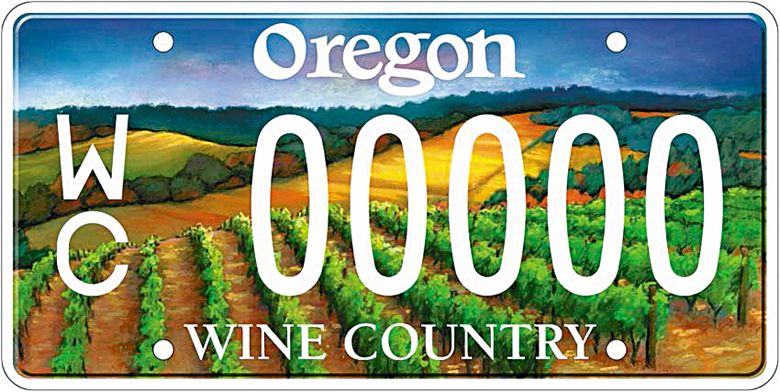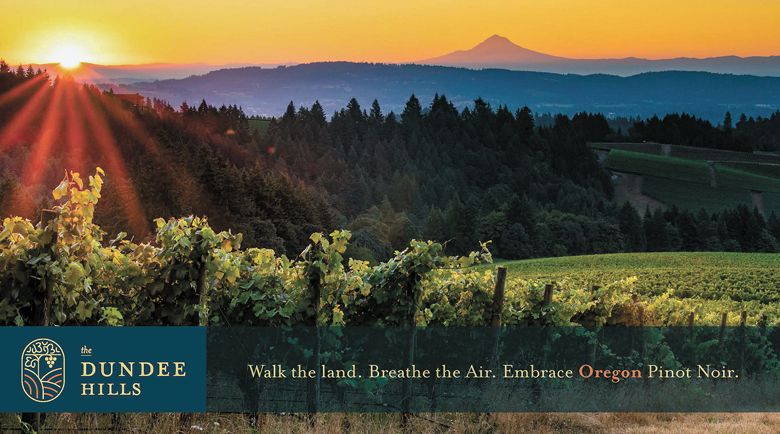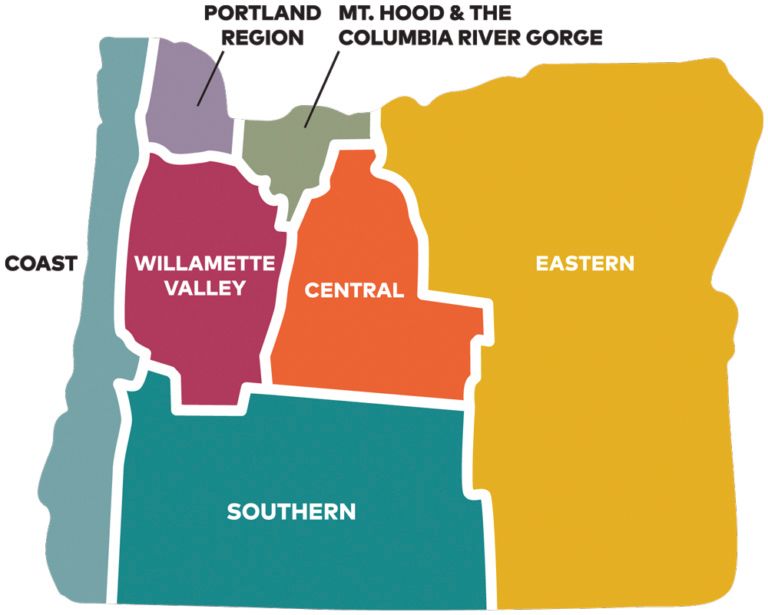Driving Oregon Wine
Vehicle plates draw attention and dollars to state's wine



By Patty Mamula
Oregon Wine Country license plates drive attention to Oregon Wine country. Beyond serving as traveling billboards, they raise funds to promote our state’s wine industry.
Since the Oregon Legislature passed a bill in 2011 to support state wine and culinary tourism projects through license plate sales, more than $3 million has been raised and distributed for tourism. These specialty license plates are considered the first to recognize wine production by any state in the United States. (Washington began offering its own wine plate in 2022.)
Revenue from the sales is equally divided between two funds. The first is a matching grant program available to tourism promotion agencies for the improvement of the visitor economy in Oregon. Projects must promote wine and/or culinary tourism.
The second is the Tourism Promotion Distribution which . . . “distributes the moneys in proportion to the amount of acreage in each region (eight in all) used for wine grape production.”
The program, administered by Travel Oregon, distributed the initial grants in 2015. Michelle Woodard, Travel Oregon Grants Manager, said, “It took time to get everything up and running. We first consulted the Oregon Wine Board when developing the process. For the program to be impactful, we needed time for the dollars to accumulate… to ensure there was enough to give out.” In the eight years matching grants have been awarded, $1.58 million has been distributed.
The amount of money Travel Oregon receives on the sale of an individual set of plates breaks down as follows, said Woodard: The wine plate surcharge (per set) is $40. The DMV manufacturing cost is $1.80. The DMV administrative fee is $2.02. The net proceeds to Travel Oregon are $36.18, which does not receive any funds to administer the program.
“Very specific entities can apply for the matching grant. Eligible applicants are the ones who have to show the match,” said Woodard. For instance, both the city of Dundee and the Dundee Hills Wine Growers Association have received matching grants. Woodard continued, “Technically, it’s a one-to-one match, but the difference is that 50 percent of the match can be in-kind service.”
“Funding has increased slightly since the beginning and so has the number of applicants,” said Woodard. The total annual DMV payment in 2022 was $400,000. (Travel Oregon receives payments monthly, but grants are distributed annually.)
In May, Travel Oregon announced the award of $390,000 through the matching grants program for 19 projects to be completed by May 31, 2024. Projects include $25,000 for the Lake Oswego Chamber of Commerce to host a Lake Grove “Wine Walk” next spring, and $15,458.50 to the Chehalem Mountains Winegrowers for the design, construction and installation of steel signage at wineries and vineyards that reflects the unique characteristics of the growing region. Clackamas County Tourism and Cultural Affairs received $11,721 to update the Mt. Hood & Columbia River Gorge cookbook.
The second fund, for tourism promotion, will notify the eight regions of the amount they are eligible to receive next January. Proposals for how they intend to use the funds are then due April 15. The entire amount distributed through this program is about $1.7 million.
Bob Hackett, executive director of Travel Southern Oregon, the designated tourism promotion agency for Region Three (Curry, Douglas, Josephine, Jackson, Klamath and Lake counties), explained how the process works for their region. “I learned early in the year that we would receive $50,000 in 2023,” he said. He then notified the two regional wine associations of their amount available. “It’s easy to divide between the Rogue Valley with 60 percent wine grape acreage, and the Umpqua Valley, with 40 percent, because they conform to county boundaries.” (The Rogue Valley includes Josephine and Jackson counties, while the Umpqua Valley includes Douglas County.)
The two wine associations next outline how they plan to spend the money, and Hackett submits a proposal online. “The proposal includes a report from the year before, and a plan for the year ahead,” said Hackett.
“Every region does it differently. This is what works for us.” He retains a modest amount for culinary marketing, to promote Food Trails (a Travel Oregon program), but most of the money goes to the associations. Hackett might also spend some on media relations and retain a small managerial fee. The wine associations can use some of these regional funds for the matching grant program.
Consider the Rogue Valley Vintners, a recently established association, and its $50,000 matching grant for 2021 to 2022. Gina Bianco, executive director, explained how the grant targeted a different type of branding. “We focused on recovery and raising visitation back to pre-COVID levels. We wanted to announce that we’re back open, she said. “Our message was, ‘Come visit us.’”
One method entailed a regional wine club. The association asked member wineries to submit wines, up to four, for a sommelier blind tasting of various varietals and years. The goal? Selecting nine to a dozen wines distributed based on membership levels—four, six or 12 bottles, three times a year—winter, summer and fall.
A portion of the money was used to promote the new wine club on social media as well as cover costs incurred for a wine club coordinator. A special Thanksgiving promotion for wineries— both before and after the holiday— encompassed digital and website enhancements. An interactive event calendar with video and photos was updated on their consumer-facing website with many free events that connected with the wineries. Additional branding activities included an email marketing campaign and online ads.
Bianco said, “We’re excited to be launching a program that combines wine and culinary hospitality, too. Rogue Table will blend wineries, hotels and chefs. We started with prototypes in 2022 to see how it would work.” For one Rogue Table event, the chef’s menu paired small plates with wines. The ticketed event drew 20 people. A sommelier came and talked about the wines and the winery owners also attended. “The wineries, chef and sommelier all got paid,” said Bianco. “This year, we’re proactively putting more of these events together.”
The remaining grants were spent on unique advertising focused on drawing people to the region. Examples were wine with biking and wine with hiking. All these promotions were under the pandemic recovery-themed umbrella.
Where did the $50,000 matching funds originate for this grant? More than half ($27,600) was a cash match. A small portion derived from member dues, some from the Tourism Promotion Distribution for Region Three and the remainder from the ASANTE Foundation, which supports the Children’s Miracle Network. They hosted the Oregon Wine Experience to support the wine industry and Rogue Valley Vintners. Less than half of the $50,000 match came from a portion of contract workers’ pay to support these activities.
Bianco, with 30-years’ experience in grant writing, said responses from the members have been enthusiastic. “Just this year, we added six new members to our organization of wineries, vineyards, businesses, hoteliers, art organizations and other services for the wine industry. We were recognized by Wine Enthusiast as a Wine Star Nominee for Wine Region of the Year. The nominees were Paso Robles, Italy, New Zealand, Argentina and the Rogue Valley.”
The Dundee Hills Winegrowers Association received a $20,000 matching grant for 2021 to 2022 to dvelop a marketing campaign targeting wine consumers residing in Houston and Chicago. The funds for the match came from member dues. “We selected two of the stronger wine-savvy markets,” said Denise Flora, director of the all-volunteer board and owner of winery Native Flora. “We wanted to learn if they were familiar with the Willamette Valley and knew of the Dundee Hills.”
The campaign combined print with digital efforts. “We mailed 30,000 postcards to residents in both cities during May/June and then again in September/October. We reinforced the postcards with digital marketing. We introduced people to Oregon and offered an Ultimate Wine Get-Away if they answered a three-question survey. To respond, they could click the link or scan the QR code,” said Flora.
Results of the survey:
1.) Have you been to Oregon Wine Country before? 76.6 percent answered no.
2.) Are you familiar with the Dundee Hills? 72.4 percent replied no.
3.) How did you hear about the Ultimate Wine Experience? Responses broke down into these percentages: 67 percent flyer, 14 percent Facebook, 18 percent other.
Seventy-one percent of survey respondents joined the association’s email list.
Flora said they contracted with two outside resources for the postcards and the digital campaign. “Although we did see a slight difference, with responses from Houston somewhat higher, we had great numbers on brand recognition with the digital campaign,” said Flora. Each campaign can be easily replicated and reused.
“We chose these cities for three reasons; 1.) their wine awareness, 2.) the Oregon Wine Board had hosted Willamette Valley Pinot tastings, and 3.) because each is located more than 50 miles away with direct flights,” Flora said.
The Dundee Hills Wine Growers recently received a new, $10,000 matching grant to support another digital campaign in the same cities. Grants manager Woodard said, “We want to make sure that folks are applying for the program and that it works.” She acknowledged that the matching portion can pose difficulties for some agencies. “The visitation numbers for Oregon are increasing, coming back to pre-pandemic levels,” she said. She also mentioned that they haven’t yet done a major assessment of the program. “We’ve had conversations with the Oregon Wine Board about that.”
Most of Oregon’s money for tourism promotion is generated from lodging taxes, usually from visitors. Hackett said, “One thing that’s different about the Oregon Wine Country license plate program is this money comes from Oregonians. They are investing in the state wine industry and want to support it. They should feel good about that. This program does do what it says it’s going to do.”










